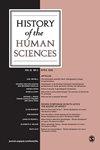The discovery of synchrony: By means of the projector as a scientific instrument
IF 0.5
2区 历史学
Q2 HISTORY & PHILOSOPHY OF SCIENCE
引用次数: 0
Abstract
This article considers the implications for film analysis of the presence or absence of a manual crank. More specifically, it looks at the 16 mm Time and Motion Study Projector as used in behavioral research in the 1960s and 1970s. The controversial concept of ‘interactional synchrony’, or the dance-like coordination of people in conversation, emerged from the use of this hand-turned projector. William S. Condon developed the concept along with the technique of microanalysis. Starting with the projector manufactured by Bell & Howell, he made numerous improvements to facilitate observation—‘sweeping’ over segments of very short duration to discover the rhythmic synchrony of all filmed participants. It led him to a theory of ‘process’ in communication, and in the reception of speech in particular. People always ‘danced’ to the tune of their own voice, and their listeners ‘danced’ to the tune of the speaker—at intervals of one-sixth or one-eighth of a second. This also led Condon to an epistemology of discovery derived partly from philosophy but mostly from his machinery. The universe, he said, is a ‘continuum of order’ whose structures are preserved through translations of order: of thought into speech, speech into vibrations, vibrations into neurons, and back into behavior. The only exceptions are people with disabilities, like the autistics Condon studied from the 1970s onward. But the very distinction of normal and pathological was epiphenomenal to his scanning technique; it was rooted in material and formal qualities of film and of the projector whose crank he turned often.同步性的发现:利用投影仪作为科学工具
本文探讨了有无手动曲柄对影片分析的影响。更具体地说,它研究了 20 世纪 60 年代和 70 年代行为学研究中使用的 16 毫米 "时间与运动研究放映机"。互动同步 "这一颇具争议的概念,即人们在交谈中舞蹈般的协调,就是在使用这种手摇放映机的过程中产生的。威廉-康登(William S. Condon)在提出这一概念的同时,也提出了微观分析技术。从贝尔& 豪威尔公司生产的投影仪开始,他进行了许多改进,以方便观察--"扫视 "时间很短的片段,以发现所有被拍摄者的同步节奏。这使他提出了传播中的 "过程 "理论,尤其是在接收言语时。人们总是跟着自己的声音 "跳舞",而听众则跟着说话者的节奏 "跳舞"--间隔为六分之一秒或八分之一秒。这也促使康登提出了一种发现认识论,这种认识论部分来自哲学,但大部分来自他的机械。他说,宇宙是一个 "秩序的连续体",其结构通过秩序的转换得以保存:思维转换为语言,语言转换为振动,振动转换为神经元,再转换为行为。唯一的例外是残疾人,比如康顿从 20 世纪 70 年代开始研究的自闭症患者。但是,正常和病态的区别对于他的扫描技术来说只是表象;它植根于胶片和放映机的物质和形式特质,他经常转动放映机的曲柄。
本文章由计算机程序翻译,如有差异,请以英文原文为准。
求助全文
约1分钟内获得全文
求助全文
来源期刊

History of the Human Sciences
综合性期刊-科学史与科学哲学
CiteScore
1.60
自引率
11.10%
发文量
31
审稿时长
>12 weeks
期刊介绍:
History of the Human Sciences aims to expand our understanding of the human world through a broad interdisciplinary approach. The journal will bring you critical articles from sociology, psychology, anthropology and politics, and link their interests with those of philosophy, literary criticism, art history, linguistics, psychoanalysis, aesthetics and law.
 求助内容:
求助内容: 应助结果提醒方式:
应助结果提醒方式:


